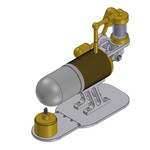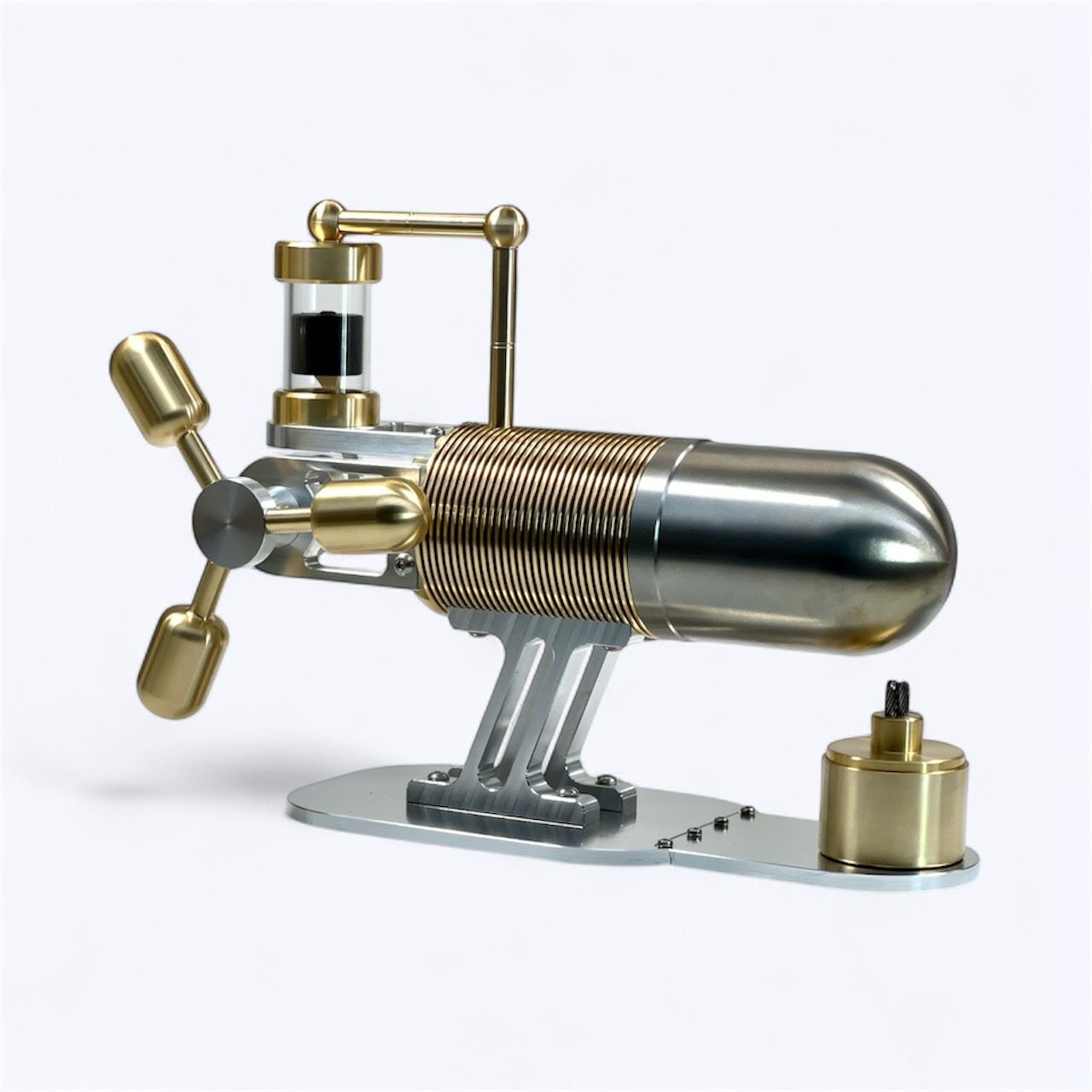Flame Pump
Gamma Engine with 90° configuration
The Kontax Flame Pump Stirling features a solid brass heatsink, a borosilicate glass cylinder, a solid graphite piston and striking brass flywheel spokes. This is a BIG engine, weighing over 1.6kg and measuring 250mm in length. it has in interesting 90° piston and displacer linkage coupled with a 90° transfer tube between the piston and main chamber. Stirling engines come in three main configurations, alpha, beta and gamma. This engine is a gamma, with a displacer inside the hot cap chamber and a power cylinder connected to it by a 90° transfer tube. The 90° configuration allows both connecting rods to attach to one crank.
How does it work?
Stirling engines work by cyclically heating and cooling the air inside the main chamber. As the air heats up it expands, and as it cools down it contracts. This expansion and contraction drives a small power piston which in turn drives the flywheel. The clever thing about Stirling engines is that the mechanism for cycling the heating and cooling of the air is built into the engine in the form of the displacer, which is driven by the flywheel and crank arrangement and moves the air from the warm side to the cool side and back again over and over.
Stirling engines are named after the inventor, Rev. Robert Stirling, who patented his idea in 1816.
Silent running
The engine is almost silent in operation, with just a tiny click coming from the conrod at each end of its stroke.
Magnetic burner
The burner features a magnetic connection to the base, which holds it firmly while allowing for small movements to fine-tune performance.
Operation
Once the burner is lit and placed on its magnetic coupling on the base, allow 30 seconds for the engine to warm up and then spin the flywheel. The engine will increase in speed over the first 2 minutes of operation before reaching its steady operational speed, which is between 600-800rpm. The position of the burner can be adjusted and fine-tuned to give optimal performance. The engine can also be run from a tiny tealight candle.
Main features:
- Spoke design flywheel
- Runs on a methylated spirits or denatured alcohol flame
- Runs on a tealight candle
- Extremely low friction self-lubricating graphite piston
- Forever wicks included (never burns down)
- Easy to adjust burner
Materials
- Aluminium connecting rod
- Stainless steel ball-race bearings
- Micron precision borosilicate glass cylinder
- Micron precision graphite power piston
- Aluminium base and feet
- Brass flyweights
- Brass body
- Aluminium displacer
- Stainless steel hot cap
Dimensions
- Base - 175mm x 75mm x 4mm thick (6.9in x 2.9in x 0.18in)
- Flyweights - 45mm long x 18mm thick (1.77in x 0.7in)
- Flywheel - 110mm diameter (4.33in)
- Power piston - 22mm diameter (0.87in)
- Hot cap - 47mm diameter (1.85in)
- Overall height - 150mm (5.9in)
- Overall weight - 1.6kg (3.5lb)
- Burner - 34mm diameter x 34mm high, 9.8cc (1.4in x 1.4in)
Assembled and Kit
The engine is available fully assembled or in self-assembly kit form. Assembly takes 35-40 minutes.
Instructions
Click the image below for PDF assembly, operation and maintenance instructions.
 |
| Flame Pump |

